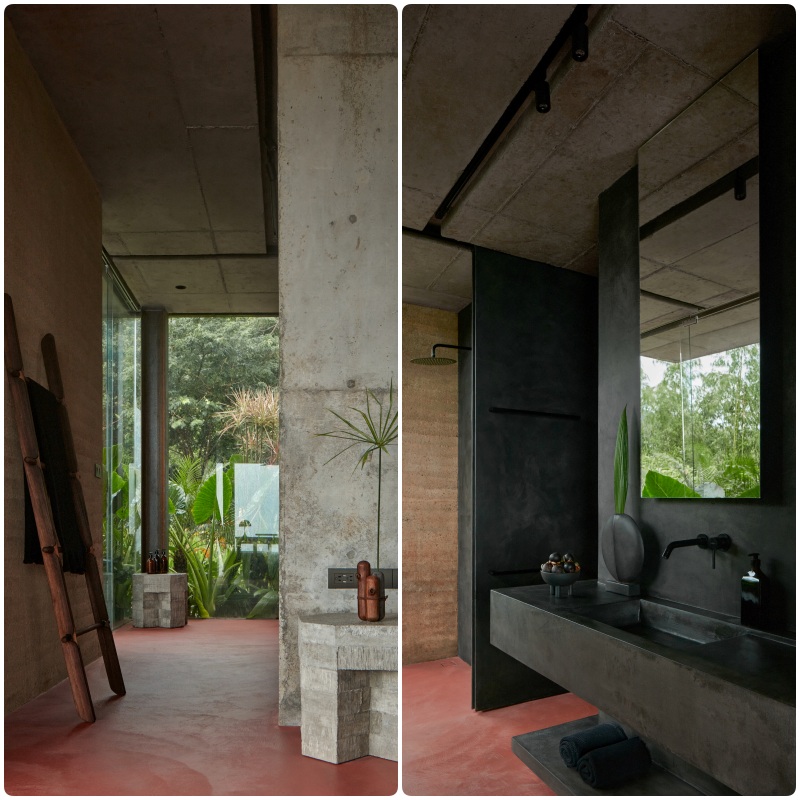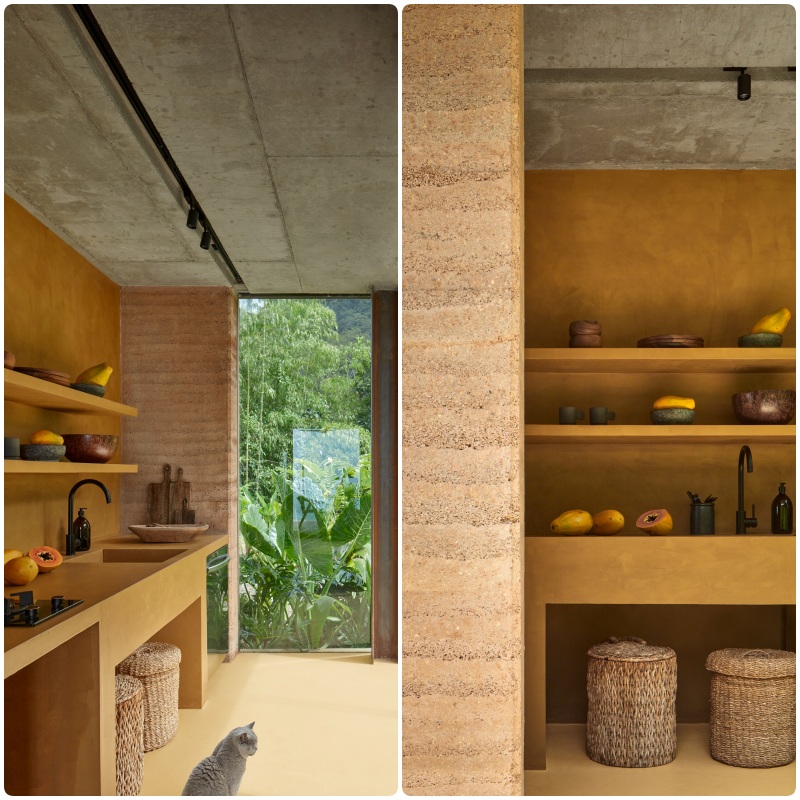A Rammed Earth Exposé in Costa Rica
Achioté is the first “rammed earth”construction in Costa Rica by Architect Dagmar Štěpánová, founder and principal architect of Formafatal. The design uses clay soil from the excavations for the construction of all perimeter bearing walls, but its not just the materials that capture our attention, it is the biophilic architecture that makes the building disappear into the forest that makes it even more spectacular.
 Near Uvita town, on a plot of 11,000 square meters at a height of 300 m above the sea, the architect of Formafatal, Dagmar Štěpánová, designed two small villas on a hill overgrown with thick forest. Both villas, partly levitating above the steep southern slope, are designed for short-term recreational rentals.
Near Uvita town, on a plot of 11,000 square meters at a height of 300 m above the sea, the architect of Formafatal, Dagmar Štěpánová, designed two small villas on a hill overgrown with thick forest. Both villas, partly levitating above the steep southern slope, are designed for short-term recreational rentals.
 Dagmar Štěpánová founded the studio in 2015 and currently employs an 11-member team with offices in Prague and Costa Rica. In addition to her architectural activities, she operates the rental of exclusive villas in the Costa Rican jungle, of which she is a co-investor.
Dagmar Štěpánová founded the studio in 2015 and currently employs an 11-member team with offices in Prague and Costa Rica. In addition to her architectural activities, she operates the rental of exclusive villas in the Costa Rican jungle, of which she is a co-investor.
“My intention was to design sustainable houses with biophilic interiors, which will be sophisticatedly thought-up and at the same time their shaping will be strongly minimalist and simple. No unnecessary extra element, but also nothing to miss,” says Štěpánová of his vision, the architect of Studio Formafatal, who was also the co-investor, project manager and construction manager of the project Achioté.
 In 2020, the Formafatal studio became the winner of The Interior Designer of The Year 2020 in the prestigious international competition Dezeen Awards 2020 and in the same year won another prestigious award in the Architizer Awards 2020 for the Atelier Villa Costa Rica.
In 2020, the Formafatal studio became the winner of The Interior Designer of The Year 2020 in the prestigious international competition Dezeen Awards 2020 and in the same year won another prestigious award in the Architizer Awards 2020 for the Atelier Villa Costa Rica.
The architectural design is based on the genius loci – on the orientation of the building plot towards the endless view of the Pacific Ocean and the morphology of the terrain. The colour concept of interiors responds to the energies that were perceived in the location of the villas before their construction.
 Although the villas are only 12 m apart, each of them has clearly different vibrations that are reflected into the interior design. The architecture of villas deliberately contrastes the lush tropical vegetation, but the chosen materials and colours are perfectly matching with the surroundings.
Although the villas are only 12 m apart, each of them has clearly different vibrations that are reflected into the interior design. The architecture of villas deliberately contrastes the lush tropical vegetation, but the chosen materials and colours are perfectly matching with the surroundings.
 “Both villas are architecturally the same. Materials, floor plan layout, or orientation towards cardinal points are also identical. However, it differs in the interior, especially by its colour concept, which is partly reflected also in exteriors,” he says.
“Both villas are architecturally the same. Materials, floor plan layout, or orientation towards cardinal points are also identical. However, it differs in the interior, especially by its colour concept, which is partly reflected also in exteriors,” he says.
 “The two villas are: Jaspis Villa (jaspis = jasper, bright villa) reflects yin energy. It is connected to the ocean and sky, not only visually, but also its vibrations. With a colour concept of sand shades, I respond to this interconnection.
“The two villas are: Jaspis Villa (jaspis = jasper, bright villa) reflects yin energy. It is connected to the ocean and sky, not only visually, but also its vibrations. With a colour concept of sand shades, I respond to this interconnection.
 “Nefrit Villa (nefrit = jade, dark villa) is a reflection of yang energy. In the Nefrit villa you can feel the connection with the ground and the jungle. Here, too, the chosen colour concept is reaction to these energies and the red-terracotta colour of the concrete floor transmits the shade of local soil to the interior of the house,” explains the architect.
“Nefrit Villa (nefrit = jade, dark villa) is a reflection of yang energy. In the Nefrit villa you can feel the connection with the ground and the jungle. Here, too, the chosen colour concept is reaction to these energies and the red-terracotta colour of the concrete floor transmits the shade of local soil to the interior of the house,” explains the architect.
 Both the villas are inconspicuous, hidden among the greens. On the sides they are lined with newly planted tropical plants. But as soon as you pass through the villa, further towards the levitating terraces, after a few steps, the view of the ocean opens up, and the generous space of the main bedroom with adjacent terraces and infinity plunge pool appears, as if you are in a different place other than the one you have entered.
Both the villas are inconspicuous, hidden among the greens. On the sides they are lined with newly planted tropical plants. But as soon as you pass through the villa, further towards the levitating terraces, after a few steps, the view of the ocean opens up, and the generous space of the main bedroom with adjacent terraces and infinity plunge pool appears, as if you are in a different place other than the one you have entered.
 “I put an extreme emphasis on all construction – architectural details and their mutual constraints. The raw visual materials of rammed earth walls and concrete are complemented by the structural steel H-beams, supporting a concrete monolithic ceiling slab. The girders and ring beam of the house are visible only in the upper face of the roof, which is lined with a pair of steel “U” profiles. They also fulfil the function of the roof attic,” says Štěpánová.
“I put an extreme emphasis on all construction – architectural details and their mutual constraints. The raw visual materials of rammed earth walls and concrete are complemented by the structural steel H-beams, supporting a concrete monolithic ceiling slab. The girders and ring beam of the house are visible only in the upper face of the roof, which is lined with a pair of steel “U” profiles. They also fulfil the function of the roof attic,” says Štěpánová.

 All facades orient to endless views of the ocean and are designed from frameless glass. The profiles of sliding and solid parts of the glass facades are recessed into the grooves in the concrete ceiling slab. This same technique is applied to the installation of interior lighting rails and the connecting rail for the mosquito net and the curtains around the bed.
All facades orient to endless views of the ocean and are designed from frameless glass. The profiles of sliding and solid parts of the glass facades are recessed into the grooves in the concrete ceiling slab. This same technique is applied to the installation of interior lighting rails and the connecting rail for the mosquito net and the curtains around the bed.

 The concrete floor slab is covered with a non-slip structured cement screed, which is different in each villa. The remaining interior walls including concrete custom-designed solid furniture, are also in the surface of cement screeds, but in smooth matte finish.
The concrete floor slab is covered with a non-slip structured cement screed, which is different in each villa. The remaining interior walls including concrete custom-designed solid furniture, are also in the surface of cement screeds, but in smooth matte finish.
“I chose the materials as durable as possible considering the Costa Rican climate and high humidity. To realise the clay “Rammed Earth” walls I invited an experienced specialist from Brazil, the owner of Terra Compacta company, because in Costa Rica no one had any experience with this construction method. Daniel Mantovani from Terra Compact trained several local craftsmen and together they can attribute their first place to realise Rammed Earth architecture in Costa Rica.
 Minimalist architecture is also reflected in interiors, where there is no door except for the large-format sliding panel in the section of the shower and toilet. It also fulfils the function of a hanger wall with a large mirror. The equipment of the interiors is mostly custom-made. Kitchen desk, sink, shelves, solitary bedside tables or bench are made from concrete.
Minimalist architecture is also reflected in interiors, where there is no door except for the large-format sliding panel in the section of the shower and toilet. It also fulfils the function of a hanger wall with a large mirror. The equipment of the interiors is mostly custom-made. Kitchen desk, sink, shelves, solitary bedside tables or bench are made from concrete.
“For some of the concrete solitaires, I was inspired by the work of the Belgian design studio Bram Vander-Beke. The creation of this studio is very close to me. Other furniture, luminaires, accessories and art were carefully selected with regard to originality, often directly from designers across all continents,” says Štěpánová.
MATERIALS USED:
Clay – perimeter bearing walls
Concrete – floor slabs, interior walls, ceiling slabs, plunge pool, furniture (kitchen unit with sink and shelves, bedside tables, outdoor bench (all according to the author’s design)
Raw structural steel /H-beams and U-beams/ – columns and rim/attic roof
Cement screed /Ecobeton Italy/ – coloured surfaces (floor and walls, furniture according to the design)
PlyRock (fibre cement board) – Sliding interior panel (shower/toilet) and dining table (all according to the architect’s design)
Glass – parts of the facade
Teak massive– beds (according to the architects’ design)
100% linen – all fabric (bedding, curtains, mosquito nets)
PROJECT DETAILS:
| Project location | Playa Hermosa, OSA Uvita – Bahia Ballena, Puntarenas |
| Project country | Costa Rica |
| Architect | Dagmar Štěpánová |
| Project year | 2019-2020 |
| Completion year | 2022 |
| Built-up Area | 190 m² / 95 m2 per villa |
| Gross Floor Area | 180 m² / 90 m2 per villa |
| Usable Floor Area | 180 m² / 90 m2 per villa |
| Plot size | 11 000 m² |
| Studio | Formafatal |
| Client | Dagmar Štěpánová & Karel Vančura |
| Photographer
|
BoysPlayNice, |
| Collaborators | Rammed earth walls: Terra Compacta [Daniel Mantovani] Statics: Ch. Vargas Garden: Dagmar Štěpánová [part of the architectural project] Realization: construction leader Willy Jeferson Céspedes Vargas + local workers Realization of screed surfaces: Different Design [Pavel Trousil], www.different-design.cz Graphic design [logo]: Zuzana Vemeová |









